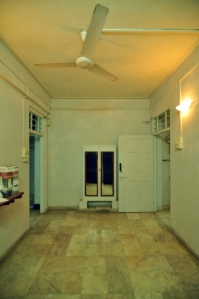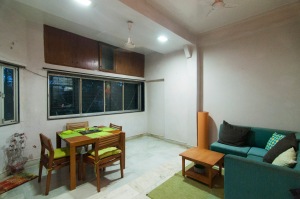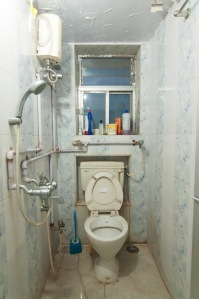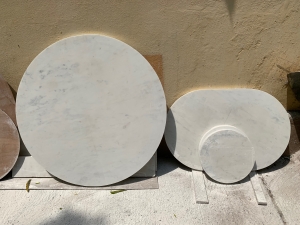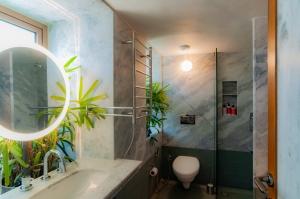Semicolon house is a second-floor dwelling in an 75 year old art deco building in Adarsh Nagar, Worli. Built by the Bombay Housing Board, these were Lower Income Group homes for small families coming to Bombay. These homes were originally built as 450 Sq.ft spaces, divided into Balcony, Room, Kitchen, Bathroom, and Toilet. In the years preceding the “BHK” style of housing now prevalent, homes in Bombay were far more fluid in space usage, and families used all their available space in multiple ways. The balcony was enclosed by windows all around, and allowed one to fully open up, or be fully enclosed. The middle room served as both a living, and sleeping room, with a dedicated almirah embedded in the wall. The kitchen was spacious, and allowed for even the bulkiest old Indian cooking paraphernalia. The bathroom, and toilet were separated to make space for larger families to use them. The height of each unit is a generous 10’-6” and its old teakwood door, and window frames had ventilators above for good ventilation. Some of the buildings have been extended about six feet to use additional FSI granted in 1995. (It still uses far less than permissible)
Pranav has lived in Adarsh Nagar since he was one, earlier in a smaller tenement, and later in one of the units described above from age five. The neighborhood is well planned, with plenty of trees, green spaces, a market, and very well connected to the whole city by public transport. In 2015, after a search for years, he finally found an apartment in one of the buildings similar to the one he lived in already, with its windows opening up to a large public park, and plenty of trees. The apartment was also mostly unchanged from its original configuration, and all its windows, doors, and even the steel almirah in the wall were intact.
In 2020, he decided to remodel the space with the same idea of space utilization, of a balcony space, a fluid in-between room, that flows seamlessly into the kitchen, and the kitchen designed to foster conversation around cooking, while being across the library, that brings the whole space together. The bed is separated from the main space by an uneven partition that feigns thickness, while bringing the two spaces together while maintaining privacy. The bathroom is now in an axis perpendicular to the original, but has two doors- giving it access both from the bed space, and directly through the kitchen, for guests. The kitchen itself moves further into the center of the apartment, where, like the original, it can expand to serve many functions. The middle room is now kitchen, dining space, and library. The entrance originally opened up into a balcony, and now has a dedicated space as entry foyer, that opens up into an enclosed verandah, study, and greeting space.
As always the studio was restrained with the use of material, using marble, kota (limestone), teakwood, and brass. Ikea cabinetry was used as the carcass of the kitchen, while adding custom teakwood fronts, and covers. The kitchen counter top and several other table tops in the home are made of 40mm thick Indian marble, that is probably the only slightly expensive part of this project. All other materials used are either the lowest cost, or are reclaimed from the same space. The decision to use a teakwood floor was as there was a severely damaged marble floor present, and the cost of replacing the same will be exorbitant. A low-cost reclaimed teakwood alternative was formulated, and used throughout. This allows for the floor to even be taken out in the future.
The original timeline of the project was 10 weeks, completed in 11 weeks, and will remain an evolving space as the residents keep changing it slightly. The studio looks at this project as a case study in small sized homes, and the lessons learnt from it will be used in many projects to come.


